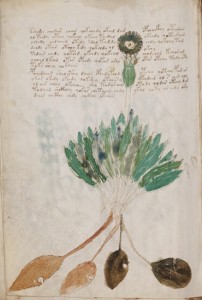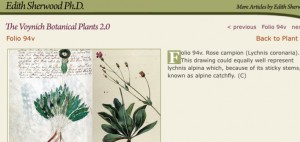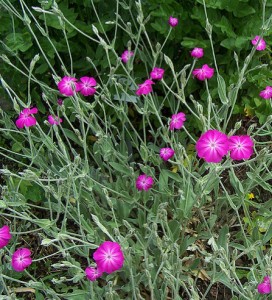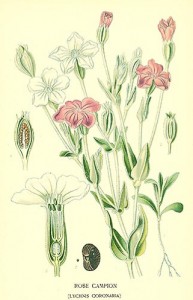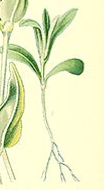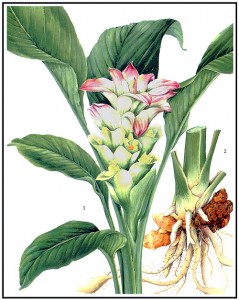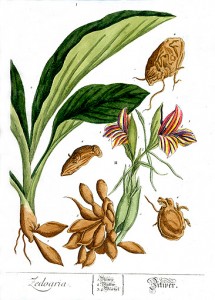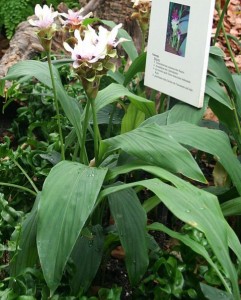Plant 94 fills most of the page, especially toward the bottom. There are two blocks of text broken across the stalk and flower head.
The plant has a thick mat of overlapping leaves, yam-like tubers on long “strings,” a central stalk with a vase-shaped calyx, narrow, pointed sepals, and a scalloped or many-petaled flower head.
The central flower stalk is a little thicker than flower stalks in some of the other VM plants. The blossom at the end of the stalk is a darkish-blue that looks like it may have been mixed with a bit of brown to darken it, or perhaps the blue was applied before the brown scalloped edge was completely dried. It appears to have been turned toward the reading audience to show its internal shape. It’s also possible that the flower itself, in real life, curves at the end.
The elliptical leaves are green and greenish-teal (a small amount of blue may have been added to the green) and some are watery blue, as though the illustrator tried to create a lighter shade of blue by adding more water. The lighter blue isn’t terribly successful, it is blobby and washed out, but does create another tone. The alternating tones might represent leaves that have a slightly different color front and back or it might be a device to make it easier to distinguish alternate leaves.
The leaves are elliptical and somewhat lanceolate at the tips. The margins are serrated. The central stalk and petioles have been left unpainted.
There are several aspects of the roots that are noteworthy. First, they are rendered in two colors, brick red on the left, darkish brown on the right. Of particular interest is the rounded notch in each one. The notch is less obvious in the fourth tuber, it’s slightly filled with pigment, but it is located in the same place as on the other tubers, if you consider each one is successively rotated counter-clockwise.
The cross- or star-like symbol on the rightmost tuber is unusual and it’s difficult to tell from a scan whether it was scored into the image after the paint was applied, or whether the scoring existed in the parchment before the paint was applied and showed as “white” because the pigment didn’t fully fill the lines. Investigation of the original manuscript with a miscroscope could probably determine whether the score lines were added before or after the image was painted.
Prior Identification
Edith Sherwood has identified Plant 94v as Lychnis coronaria, Rose Campion, probably based on the numerous basal leaves and the fact that it has a vase-like calyx.
Other than these two points, however, Lychnis coronaria differs from Plant 94v in several ways:
The basal leaves of L. coronaria are difficult to see under the multitude of long slender branching stems and distinctive flower heads (L. coronaria Image courtesy of the Göttingen Viewux jardin botanique). The roots of L. coronaria are somewhat fine and delicate (right), not tuberous like 94v.
- L. coronaria tends to branch many times, with small opposite leaves at the branch nodes.
- L. coronaria typically has four or five larger petals emanating from a very tiny steeple in the center, while Plant 94v appears to have many small, short petals surrounding a larger inner ring.
- L. coronaria does have a basal whorl when the plant first starts, but the basal leaves are quite ruffled, not serrated, and are barely visible in mature flowering plants. The long slender branching stems and bright pink or white blossoms overwhelm the view of the basal leaves as the plant blooms.
- L. coronaria does not have large rounded tubers. The roots are somewhat delicate and hairlike.
Other Possibilities
Apios tuberosa (American ground-nut) has yam-like tubers and somewhat elliptical leaves, but the leaves are arranged very differently from 94v, and the long plumes of flowers aren’t a match either. It’s a vine rather than an upright plant, so it probably has to be ruled out as a contender.
Harpagophytum procumbens (Devil’s Claw) has yam-like tubers attached to long strings, but the leaves are quite different from 94v. They are palmate, with very ruffled edges, and somewhat feathery compared to the leaves of 94v. The flowers are trumpet-shaped. Except for the flowers, H. procumbens, is a closer match to Plant 93v than Plant 94v.
Cyperus has yam-like tubers on strings, basal leaves, and a central stalk, but the tubers are small and the flower head doesn’t match 94v—the flower heads are branching and grain-like.
Asphodelus alba is a little closer to the VM plant in that it has yam-like tubers, many basal leaves and a flower head on a central stalk, but the flower is a long plume of blossoms with prominent stamens rather than a vase-shaped single flower-head. It’s worth considering, but probably isn’t a match.
Cochlearia armoracia (Horseradish) has many serrated basal leaves, a sometimes-rounded tuber and a central flower stalk with petals at the end. the main difference from the 94v stalk is that Cocklearia branches.
The above plants tend to resemble Plant 94v in having prominent basal leaves that are roughly elliptical, yam-like tubers or bulbs, and a central stalk with a flower on the end. The biggest difference between these plants and 94v is that the flower heads are somewhat or significantly different from 94v.
Curcuma longa (turmeric, left) has long been known as a medicinal plant and has elliptical/lanceolate leaves that can be quite large and numerous. In contrast to Plant 94v, however, the leaves tend to rise above the flower stalks.
Curcuma zedoaria (ginger, center) also has yam-like tubers at the ends of long “strings” and elliptical/lanceolate leaves growing from the base (C. zedoaria photo by Michael Wolf, GNU Public License).
Of the plants mentioned so far, a species of Curcuma with leaves not as high as C. longa seems like the best choice except for the flower head and the fact that the leave margins are somewhat irregularly smooth rather than serrated. The Curcuma calyx differs from the 94v flower head with overlapping protrusions and lighter “petals” that follow the same general pattern.
What is noteworthy, however, is that Curcuma flower stalks grow from a leafless underground rhizome. Could the two reddish tubers on the left and two darker tubers on the right represent the leaf part and the flower stalk drawn together? Curcuma stalks and leaves grow in the same vicinity, and rhizomes connect different above-ground plants, but the stalks and leaves are separate in the sense that the stalk doesn’t actually rise from the center of the leaves, it rises from a rhizome.
Or is there another plant with a comparable flower head and serrated leaves that better matches 94v, perhaps a broadleaved Senecio?
Posted by J. Petersen

